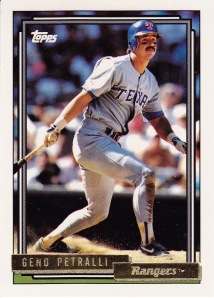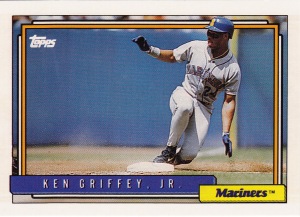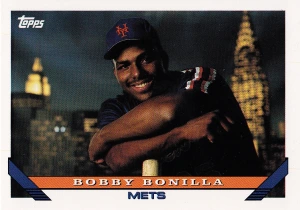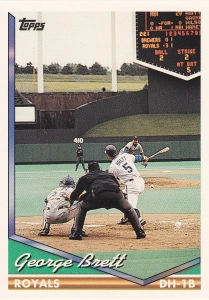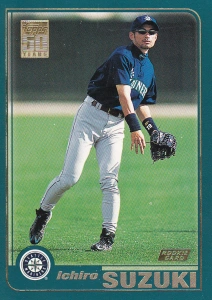Highlights and Events:
1991 was the first season where free agency really became what we know it today; Darryl Strawberry was the first example of a high-profile free agent who switched teams for more money when he was considered one of the best players in baseball (at least since the late 70’s / early 80’s). The 1992 season, however, one-upped the previous year. New York naturally jumped in – sluggers Bobby Bonilla and Danny Tartabull signed huge contracts with the Mets and the Yankees, though neither player would recapture their former production. Frank Viola left the Mets for a bigger deal in Boston, and he never regained his Cy Young stature. Other free agents included Eddie Murray (Mets), Dave Winfield & Jack Morris (Blue Jays), Mariano Duncan (Phillies), and Gary Sheffield.
There were two big trades, as Brett Saberhagen was traded from KC to the Mets for a number of players, including Gregg Jefferies. The trade with the most lasting impact, however, was a crosstown deal where the White Sox got former MVP George Bell but gave up a young budding star with a tendency for striking out named Sammy Sosa. Youngsters Curt Schilling (Phillies), Kenny Lofton (Indians) and Gary Sheffield (Padres) were also traded before they had become established stars.
Expansion was a year away, but the Rockies and Marlins both signed their first players. The Rockies signed Stanford graduate – outfielder Ryan Turner, while the Marlins signed pitcher Clemente Nunez of the Dominican Republic. Neither player made it to the major leagues. The teams also participated in the MLB draft in June – future All-Star catcher Charles Johnson – of the University of Miami – didn’t have to move far when the Marlins took him. The Rockies drafted pitcher John Burke, who made it to the Big Leagues but pitched in only 28 games.

The most significant development in 1992 may have been the new era in ballpark design that was ushered in. After years of “cookie cutter” style ballparks built to house both football and baseball franchises. On April 6th, Oriole Park at Camden Yards ushered in the Retro Park era. Built near the Baltimore Inner Harbor, the park took nearly 3 years to build but set a trend that has continued to almost every park built since then.
The traditional “powers-that-be” held their place in 1992. The Blue Jays, Braves and Pirates all repeated as division champions, while the A’s won their 4th division title in 5 years.
Oakland (96-66) beat out the Minnesota Twins (90-72) for the AL East crown; this was the 6th straight year that one of those two teams had won division. The A’s got 42 home runs from Mark McGwire and the standard .400+ OBP from Rickey Henderson, though this continued a trend where they never seemed to get a great season from both Canseco and McGwire. Canseco was sent to Texas at the trade deadline for Ruben Sierra, Jeff Russell and Bobby Witt. Dennis Eckersley stole the show, however, with his 5th straight dominant season. Eck saved 51 games with a 1.91 ERA, blowing only 3 for an incredible 94% success rate. This netted him the Cy Young and MVP awards, a rare feat for a reliever.
The Blue Jays were already a great team in 1991, but signing veterans Jack Morris and Dave Winfield via free agency gave them an even more formidable attack. Morris led the majors with 21 wins, following up his World Series MVP with a 5th place Cy Young finish. Winfield slugged 26 home runs and knocked in 108 runs, earning 5th place in the MVP voting – he also had the game-winning RBI in the deciding World Series game. He was one of 3 Blue Jays in the top 6 in MVP voting; Joe Carter was 3rd after 34 homers and 119 RBI, while Roberto Alomar was 6th, scoring 105 runs with 49 stolen bases and his second straight Gold Glove.
 In the National League, the Pirates won their third straight division crown and the Braves defended theirs. In his final year in Pittsburgh, Barry Bonds flip-flopped with Terry Pendleton for 1st and 2nd in the MVP voting. Bonds had an incredible stat line – 34 HR, 103 RBI, 109 R, 39 SB, 127 BB along with averages of .311/.456/.624. Andy Van Slyke hit .324 with 199 hits. Unfortunately for the Pirates, this was not only the last time they went to the playoffs – it was the last time they had a season above .500.
In the National League, the Pirates won their third straight division crown and the Braves defended theirs. In his final year in Pittsburgh, Barry Bonds flip-flopped with Terry Pendleton for 1st and 2nd in the MVP voting. Bonds had an incredible stat line – 34 HR, 103 RBI, 109 R, 39 SB, 127 BB along with averages of .311/.456/.624. Andy Van Slyke hit .324 with 199 hits. Unfortunately for the Pirates, this was not only the last time they went to the playoffs – it was the last time they had a season above .500.
Pendleton again was the best offensive player for the Braves – he followed up his MVP campaign with 105 RBI and 98 runs. Ron Gant and Dave Justice had solid power numbers, but pitching was again the key for the Braves. Tom Glavine again led the league with 20 wins; like Pendleton with the MVP, he was second in defending his Cy Young award. Behind him, John Smoltz, Steve Avery and Charlie Liebrandt were all very solid.
Ken Griffey Jr. highlighted a mid-summer classic; he was a triple short of the cycle and joined his father as the first father-son combination to win an All-Star game MVP award. Griffey had another solid season, with 27 home runs, 103 RBI and a .308 average. The American League won the game 13-6, the day after Mark McGwire won the home run derby.
The Olympic Games added baseball as a medal sport for the first time. Team USA featured future stars Jason Giambi and Nomar Garciaparra, and made it through round robin to the semi-finals. But they lost to Cuba and Japan to finish a disappointing 4th place. The Cuban team which won the Gold Medal featured future 4-time World Series champion – “El Duque”, Orlando Hernandez.
A number of players had great seasons outside of the division champions. For the 2nd place Twins, Kirby Puckett had his best season with a .329 average, ML leading 210 hits, and over 100 RBI and runs. For the third place White Sox, Frank Thomas had similar numbers, though he also had a league best 122 free passes. Cecil Fielder led the American League in RBI for the third straight time, while the home run title went to young Juan Gonzalez (43). Sheffield won a batting title (.330) for the Padres and had a legitimate shot at the triple crown with a week left in the season – while his teammate Fred McGriff denied him for the HR title (35). Darren Daulton took the RBI title at the catcher position, with 109. Greg Maddux was the most notable on this list. Playing for the sub-500 Cubs, he led the league with 20 wins and a 2.18 ERA to win the first of his 4 straight Cy Young Awards.
On September 7th, a big change was made in the MLB leadership. Fay Vincent was voted out by the owners as commissioner. Vincent had an interesting tenure, but he often came across as ridiculous with threats he couldn’t back. Ultimately, he forgot who he really worked for. Milwaukee Brewers owner Bud Selig, who is still the commissioner today, replaced him.
There were some significant milestones and accomplishments in 1992:
 In September, Robin Yount singled off of Cleveland’s Jose Mesa for the 3,000th hit of his career.
In September, Robin Yount singled off of Cleveland’s Jose Mesa for the 3,000th hit of his career.- In the same month, George Brett became the 18th member of the 3,000 hit club – with a single against the Angels’ Tim Fortugno that capped a 4-for-4 day.
- On June 15th, Jeff Reardon passed Rollie Fingers to set the all-time record with save number 342. He would hold the record for less than a year.
- Mickey Morandini of Phillies completed the 9th unassisted triple play in Major League history.
- After back to back seasons of 7 no-hitters, Kevin Gross of the Dodgers had the only no-hitter in 1992, a 2-0 win where he walked 2 batters.
- Bip Roberts set a major league record with the Reds where he had 10 consecutive hits.
- Kenny Lofton set the AL rookie record for steals, leading the league with 66.

If there was some doubt as to who the best hitter in baseball was in 1991, there was not question in 1992. Barry Bonds had his best season on record, winning the NL MVP for the 2nd time in 3 years, with a 2nd place sandwiched in between. No one else was really even close – though behind him for second it would have been interesting between Will Clark, Ryne Sandberg and Rickey Henderson, with young stars like Frank Thomas and Ken Griffey Jr. beginning to enter the argument. But Bonds was king by a wide margin for now.
Roger Clemens was still clearly the best pitcher in baseball, though Greg Maddux and Tom Glavine were moving up into the argument.
Read on for the 1992 postseason summary…
Read the rest of this entry »



























